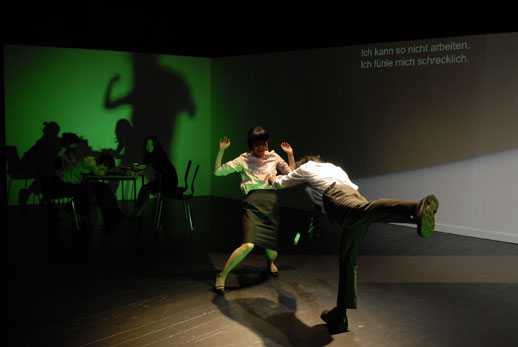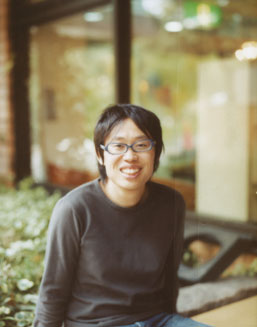Instructing Audiences — A Theater Text Like A Pill
Toshiki Okada is the playwright and director of chelfitsch, a young Japanese theater group that rose to near-unanimous national acclaim in the past six years. In 2007, they were invited to the Kunsten Festival des Arts, and since then have received invitations and praise from international presenters and audiences.
Despite their wild popularity, the work of chelfitsch is subdued, thoughtful and spastic. Until recently, the text spoken by the young performers was colloquial almost beyond recognition, endlessly starting but going nowhere. The jerky, idiosyncratic movements of the actors (simultaneous but not synchronized with the speech) are reminiscent of social gestures and daily movements that aid communication, but here, these movements never complete themselves or communicate. The parallel events of speaking and moving leave both the narrative event and the actor in a constant state of willing itself into being, without ever arriving.
We interviewed Okada while chelfitsch was in rehearsals for a new piece, Who Knows We Are Not Injured Like the Others?, scheduled to premiere at Yokohama’s ST Spot in mid-February.
Can you talk about the relationship between text and movement in your work?
In conventional theater, the relationship between movement and speech seems to be connected directly. But in my opinion, in our everyday life, when we talk about something or when we move, we deal with them as not connected. Before I founded my methodology about the relationship between movement and speech, I felt something was wrong when I watched conventional theater. But I was not sure why. While I was working in the studio with my colleagues, the actors, we were understanding, little by little, this mechanism.
Movement and speech have a relationship, but it is not a direct one. In my opinion they are connected through “image”. “Image” is the word we use in our studio, so I am not sure if its appropriate or not. “Image” means something that precedes speech and movement. I think “image” is the common mother of speech and movement. In conventional theater, speech seems to be the mother of movement, but I don’t think this is so. They are both children of “image”, their relationship is a brotherhood, not a mother-child relationship. When I had this idea, it clarified many things for me. So since then, we have been developing a methodology which is based on this idea.
But when you make your pieces, you write text first.
Yes, that’s true.

And then with the actors, you create movement and how to speak the text. Here, the father of the text seems to be you. So the image which precedes text is your image or impulse, but the image that precedes movement belongs to the actors, is that right?
But I have no image when I write a text. The only thing I have when I write a text is to try and inspire the actor’s movement. I don’t know what will inspire them, I don’t have a concrete expectation, but I expect something interesting can be generated by the actors. And in the past two years, my text has no rigid composition. I write just the speech, just fragments with no plan. I don’t decide anything before rehearsal: who speaks this text? In what order is it spoken? All those things are decided through rehearsal. In our latest work, which we are rehearsing now, I don’t intend to set only one structure for the performance. I want to show the piece but I don’t want to lose the variety of interesting possibilities. So, in twenty performances, we will use many different possibilities of structure (of course using only one per night). By doing this I want to keep a range of possibility.
If you change the form of the piece every night, the message seems to be that the performance itself is not solid, and can allow many points of view. That leaves me with the question of what is your point of view? If the form of the performance changes, what is the thing that remains the same? Whatever remains constant, I think, represents your point of view.
The important thing for us is: what should we give to the audience? What kind of representation can we give the audience? That idea is always the same. If we can do that, any form is OK. In our rehearsal there is a lot of trial and error, so we are learning a lot. Some things seem to work better than others.
By representation you mean using text and movement to indicate a character or event?
Yes.
So the basis of representation in your works is the disconnection between text and movement?
Yes, that’s right. But in our new piece, which we are rehearsing now, the speaking actor is not the representing actor. For example one actor is standing there and another actor is speaking. The audience sees the standing actor and listens to the speaking actor, and in the audience’s mind, the representation is completed.
Our new piece is dated August 30, 2009. That day was the election, and as a result, the dominant party in Japan changed. It was a big event for us. But I am not sure what it means and I don’t know where we are headed. So I want to describe my confusion, in this piece, through the story of one couple. The couple belongs to the middle class. In my childhood, everyone believed that we are all in the middle class. I think it’s not true, but that illusion worked really well. But now, this illusion has vanished. So we Japanese are confused. We are not familiar with the existence of class, the idea of class. But from now, “class” will be obvious. I too am confused. Now I think it would be great to describe this kind of confusion through this piece.

When I first started writing I was interested in naturalism. So I wrote in that way because I thought that is how people speak. You can’t understand what they are saying most of the time. Now I want to quit that kind of writing. I am not so interested in naturalism these days, in representing something in a realistic way. In the 1990s in Japanese theater, some artists who used naturalism became dominant, like Oriza Hirata. That’s how I became interested in it.
But now, I have come to believe that realism is concealing the fact that what is done on the stage is not real. The actor is not the character. The action on stage is not the event itself. Now, I am interested in representation without this kind of concealing. So, as you said, I was writing in this kind of hyper-colloquial Japanese. But this may have contributed to the act of concealing.
So, now, my writing is not like that at all, it’s very simple, just like instructions. These days, I think that the text is an instruction to the audience. The text is like a pill; I make the audience drink this pill, and in the audience’s mind, the text and the body are combined, and therefore representation is completed. I am very interested in this essential quality of theater.
Is there anything in Japanese culture, contemporary or traditional, that your work connects to?
Now I am interested in Japanese calligraphy. For me calligraphy is a juxtaposition of meaning and materiality. A great calligraphic artist should not think about the meaning of the letter when he or she is drawing it. When I think about theater, conventional acting seems to conceal materiality, in favor of representation. But it is not necessary I think. One thing that interests me is achieving representation without concealing materiality. To present a performance is a juxtaposition of representation and materiality. That is the way to make a strong performance.
This interview originally appeared in translation in the Finnish magazine Esitys, published on February 15, and is re-printed here with their kind permission.
Who Knows We Are Not Injured Like the Others? by chelfitsch runs February 14 to March 10. For more details, see chelfitsch.net
Yelena Gluzman
Yelena Gluzman



